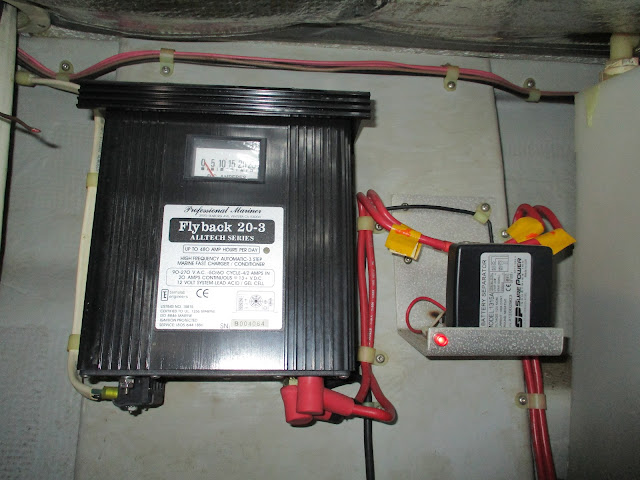Battery Issues
 |
| Battery Charger & Separator |
What you think you have might not be what you actually have. That's what a friend of mine told me when discussing the setup in my boat...and he was right.
The Camano was built with a Battery Separator. Instead of a mechanical battery switch, the separator is tied to the engine battery and the house battery bank.
The unit does 2 things. 1. Assist in engine starting: When the engine starter is activated, the separator compares the voltage of both battery banks. If the start/engine battery is lower than the house battery bank, the Battery Separator will engage allowing the house battery to "aid" in starting. 2. Protect the starting system: The Battery Separator monitors the battery system to determine if the batteries are being charged. When the engine or house batteries reach 13-13.5 volts, indicating that charging is taking place, the Battery Separator will engage, joining the two battery banks. If the drain on the charging system by either battery bank reduces the system voltage below 12.4-12.9 volts, the Battery Separator will disconnect the battery banks from each other, protecting each bank from excessive drain.
...that is what is supposed to happen. Not until placing a voltage meter on each battery did I realize that although my engine battery was charging from the engine alternator, the house bank was not! There is a red indicator light on the battery separator which would come on indicating it was indeed working. It was not. When Pau Hana was in the marina and on shore power, the battery charger itself worked to keep the batteries topped off and when out on the water my solar panels kept the house banks charged, so I had no idea there was a problem.
 |
| Top of Battery Separator |
I did two things. First I wanted a way to "at a glance", monitor the battery banks. The existing analog volt meter worked fine but I needed to bend down and operate the switch to show the charge on the analog meter of either bank. I decided to remove the analog volt meter and the switch and install multiple meters that would be easy to view constantly. I located a LED dual voltage meter.
I made a panel that fit over both the analog meter and the switch hole. I added some voltage baselines to give me an idea of the current state of the batteries and not allow the batteries to fall to a damage level.
To start, I turned off the solar panels, disconnected all of the positive battery terminals, and turned off the battery charger and with a multimeter, tested to ensure I had no voltage coming in.
The installation was pretty straight forward. Remove the switch, lengthen the wires some and install the connectors for the new dual voltmeter. The 2 top screw holes of the new panel lined up with the top holes of the old analog meter. That meant using the 2 bottom holes of the new panel as a guide to drill the bottom screws.
Next I replaced the battery separator. This installation was also straight forward. I labeled each positive battery line to be sure I connected them properly.
I reconnected all the battery terminals and the new dual meter indicated the voltage at both battery banks. Next I started the engine and I could see that as the key was turned, the voltage on the engine battery dropped, then immediately started to increase, then I could see that the house bank voltage was increasing as well.
 |
| The Meter shows the Batteries "Bulk" Charging |







Comments
Post a Comment